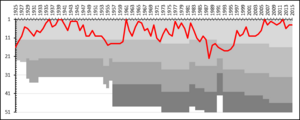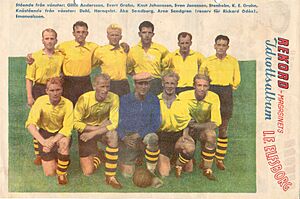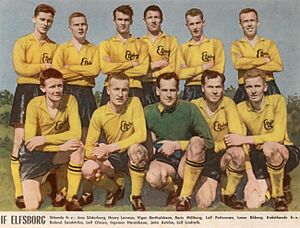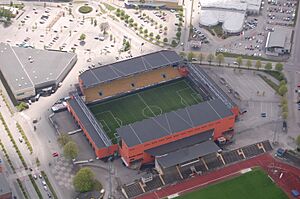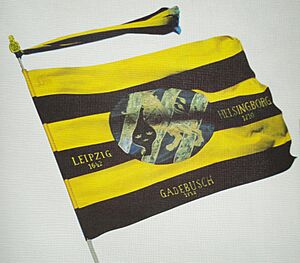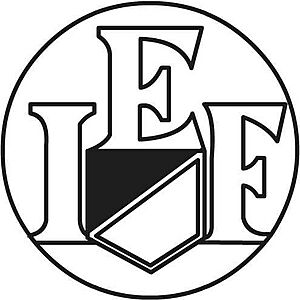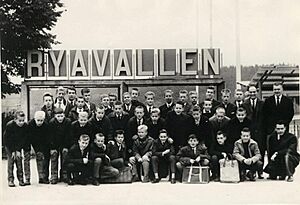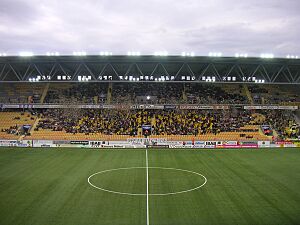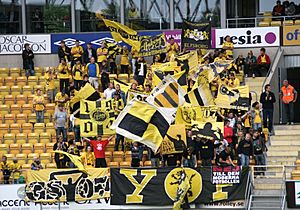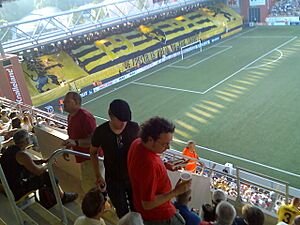IF Elfsborg facts for kids
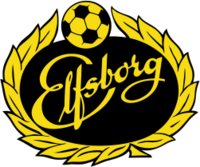 |
||||
| Full name | Idrottsföreningen Elfsborg | |||
|---|---|---|---|---|
| Nickname(s) | Di Gule (The Yellow Ones) Eleganterna (The Elegants) |
|||
| Founded | 26 June 1904 (as Borås Fotbollslag) | |||
| Ground | Borås Arena, Borås | |||
| Capacity | 14,500 | |||
| Chairman | Sune Lundqvist | |||
| Manager | Oscar Hiljemark | |||
| League | Allsvenskan | |||
| 2024 | Allsvenskan, 7th of 16 | |||
|
||||
Idrottsföreningen Elfsborg, often called IF Elfsborg or just Elfsborg, is a professional football club. It is located in Borås, Sweden. The club is part of the Västergötlands Fotbollförbund. They play in the Allsvenskan, which is the top football league in Sweden. Elfsborg has spent most of its history in this top league. Their home stadium is Borås Arena. They have played there since April 17, 2005.
The club started in 1904. It was founded by 19 young people, all around 14 or 15 years old. They first called it Borås Fotbollslag. This happened on June 26, 1904. Carl Larson was a key person in starting the club. He also enjoyed athletics and wrestling. He said they started the football club because the main sports club in Borås did not offer football.
In 1906, the name changed to IF Elfsborg. This was because there were too many clubs with "Borås" in their name. The new name comes from Älvsborg County. They used an older spelling with an "E" instead of "Ä". The club's colors, yellow and black, also come from this region. They are from the Älvsborg Regiment flag. Elfsborg wanted to represent a whole region, not just a city. A common saying for the club is "Vi Tillsammans" (We together).
Elfsborg's home stadium, Borås Arena, is also known as Elfsborg Fortress. This is because Elfsborg has been one of the strongest home teams in the Allsvenskan during the 2000s. Elfsborg is one of only two teams in Allsvenskan to have beaten the Sweden national team. They won 2–1 at the opening of their old stadium, Ryavallen. The other team was AIK in 1979. Elfsborg is also one of only two teams to win the Allsvenskan as newcomers. They did this in 1961. The other team was Östers IF in 1968. Elfsborg has often played in qualifying rounds for the Champions League and Europa League. In 2007, they were in the 2007–08 UEFA Cup. They were also one of the winners of the 2008 UEFA Intertoto Cup the next year. The club has won six national championships. Their most recent win was in 2012. They have also won three national cups.
Contents
Club History
Borås Fotbollslag was started on June 26, 1904, by a group of young people. In 1906, the name changed to IF Elfsborg. The founders felt there were too many teams with 'Borås' in their name. In 1926, Elfsborg won the Västsvenska Serien. They beat Halmstad BK in a play-off game. This meant they were promoted to the Allsvenskan for the first time.
During the 1930s, Elfsborg built a very strong team. It was led by the striker Sven Jonasson. He played in both the 1934 and 1938 World Cups. In 1936, Elfsborg won the Allsvenskan for the first time. They won two more titles soon after, in 1939 and 1940. During this time, Elfsborg had as many as seven players on the Sweden national team.
In 1941, Elfsborg moved from Ramnavallen to play at the new Ryavallen stadium. The first game there was supposed to be Sweden vs. Finland. But Finland could not play due to World War II. So, Elfsborg played instead and beat Sweden 2–1.
In the mid-1940s, Elfsborg almost won the Allsvenskan again. They finished second for three years in a row. By the late 1940s, Elfsborg's best days were fading. The club was moved down to a lower league in 1954.
In 1960, Elfsborg won promotion back to the top league. They had an amazing season with 20 wins in 22 games. The club then won the Allsvenskan for the fourth time in 1961. They became the first Swedish team to go straight from the second level to becoming champions. This happened under the leadership of chairman Sven Andreasson.
In 1977, Elfsborg finished in second place. But the years after that were tough for the club. In 1987, Elfsborg finished last in the Allsvenskan. They did not return to the top league until 1997. The team that won promotion included future Swedish national players like Anders Svensson and Tobias Linderoth. Even though Elfsborg won their first two cup titles (in 2001 and 2003), the club struggled to stay in the Allsvenskan in the years that followed.
In 2005, Elfsborg spent a lot of money. They built Borås Arena and brought back former players. These investments paid off. The club won its fifth Championship in 2006. This was their first Allsvenskan title in 41 years. The next year, Elfsborg played in the Champions League qualifying stage for the first time. They then reached the group stage in the UEFA Cup. On their way, they beat Linfield FC (Northern Ireland) and Debreceni VSC (Hungary). They were then knocked out by Valencia CF (Spain). The club won the last qualifying round for the UEFA Cup against FC Dinamo București (Romania).
In the group stage, IF Elfsborg played against AC Fiorentina and Villarreal away. They also played AEK Athens and FK Mladá Boleslav at Borås Arena. They were eventually knocked out.
In the years that followed, IF Elfsborg became a top club in Swedish football. This was under coach Magnus Haglund. Their goal was to finish in the top 4 each year to qualify for European football. In 2007, they finished 4th. This earned them a spot in the last Intertoto-cup. They moved forward from there but were surprisingly knocked out by St Patrick's Athletic F.C. in the UEFA Cup.
The team recovered and competed for the title again in 2008. But injuries to key players like Anders Svensson and Stefan Ishizaki were too costly. They ended up in second place behind Kalmar FF.
The next year, IF Elfsborg again aimed for a spot in European football. They easily beat Hungarian team Szombathelyi Haladás and Portuguese team S.C. Braga. They were finally stopped in the last qualifying round by S.S. Lazio.
IF Elfsborg was a big favorite to win the 2009 season. But they had trouble scoring goals despite having the ball a lot. They ended up in third place behind AIK and rivals IFK Göteborg.
Expectations were still high for the next season. But a slow start in 2010 made it hard to catch up. Helsingborgs IF and Malmö FF were too far ahead. Malmö FF became champions, and IF Elfsborg finished fourth.
2010 was IF Elfsborg's fourth year in a row playing in European competitions. They entered the Europa League and easily beat Moldovan team FC Iskra-Stal. The Macedonian team FK Teteks was also not a challenge. IF Elfsborg won that round 5–0 in the first game.
The team looked ready to reach the Europa League group stage. But they faced a very tough opponent, SSC Napoli. Elfsborg managed a 1–0 loss away from home. This was thanks to a great effort by new Danish player Jesper Christiansen. But the Italian team was too strong in the second game. They won 2–0, with both goals scored by Edinson Cavani.
The 2010 season also saw many player changes. Swedish international Emir Bajrami moved to FC Twente. Top goalscorer Denni Avdic went to Werder Bremen. Three players were signed from Danish clubs. Former player Jon Jönsson came back from Brøndby IF to help the defense. Goalkeeper Jesper Christiansen joined from FC København. Right back Andreas Klarström returned to the club from Esbjerg fB.
In the winter of 2010–2011, the club made more important signings. They brought in forward Lasse Nilsson from Vitesse Arnhem. Central defender Andreas Augustsson joined from Randers FC. Striker David Elm came from Fulham F.C.. Many experts thought IF Elfsborg would win the 2011 season.
In early spring, former Allsvenskan top scorer Fredrik Berglund decided to stop playing football.
The 2011 season showed IF Elfsborg playing a more direct, counter-attacking style. The team started winning more away games. By the middle of the season, they were close behind Helsingborgs IF at the top. Young left winger Niklas Hult was the best player during this time. He quickly became a key part of the team. Some in the media even called him "the new Freddie Ljungberg".
In European football, IF Elfsborg started in the first qualifying round of the Europa League. They easily beat CS Fola Esch by winning 4–0 at home and drawing 1–1 away.
Team Colors and Crest
Since Elfsborg was founded, they have worn yellow as their main color, with some black stripes. The yellow and black colors come from Älvsborg County. The Älvsborg Regiment had yellow and black on their flag. So, Elfsborg decided to play in these colors. This meant yellow shirts and black shorts. For a long time, the uniforms were just plain yellow and black. There was no club name on the chest or back. This stayed the same until the 1940s. Then, it became popular in Sweden to put the club badge on the shirt. This helped clubs build their brand. For Elfsborg, it was the classic black text "Elfsborg" in italics on the chest, over the heart. This classic text was on the shirt for almost 50 years, from 1940 until 2007.
In 2007, they changed to what is now the official club emblem. This emblem came from the 1970s and has been used in different ways by many Elfsborg sections. It is a yellow and black crown with "Elfsborg" written in it, and a football at the top. The main reason for the change was to promote the club's brand. They wanted a symbol that people and companies could easily recognize.
Elfsborg's away kit is red. This is a tribute to a match in 1941 against the Sweden national team. That game was meant to celebrate Elfsborg's new stadium, Ryavallen. But because of World War II, Elfsborg had a problem. Their yellow kit was the same color as their opponent's. So, they quickly borrowed a red and white kit from a local company. Elfsborg won that game 2–1. This win was remembered with the red kit. Sweden played in yellow. The colors red and white are also important symbols of the city of Borås. They are on the city's coat of arms, which has two scissors. Elfsborg is special because they are the only team in Allsvenskan history to have beaten the Sweden national team.
Sponsorship
For a long time, the shirts did not have a main sponsor. This affected the club's money. In the early 1990s, when Elfsborg was struggling in a lower league, Olle Blomqvist, the CEO of Ellos, helped the club. He gave a lot of money and became the main sponsor. He did this because he knew how important Elfsborg was to Borås and the Sjuhärad region. Ellos became such a big sponsor that people jokingly called the team "Ellos" because their name was on the shirts. In 2010, a study showed that Elfsborg was the second-best team in Allsvenskan at getting sponsorship money. They were also good at keeping in touch with their sponsors. That same year, Elfsborg broke a record for local sponsorships. Their sponsor money increased from 28 to 33 million SEK.
More recently, they signed deals with major sports brands. Elfsborg has a contract with Umbro. They use Umbro's football shoes and clothes. Umbro's sponsorship was so strong that a part of Borås Arena was named "umbrocorner". In earlier years, teams often made their own shirts. But with a contract from a big brand, new shirts are released every year. This is good for the club's finances.
Stadiums
One of Elfsborg's first home grounds was a small grass field in Folkparken. But Elfsborg quickly realized they needed more space for training and matches. They went to Fristad and Fristads hed, where they practiced and played. The next ground in Borås was Apotekarnas Mosse. This later became today's Ramnavallen.
Ramnavallen was finished in 1922. Elfsborg finally had their own stadium. It was very modern for its time, even though it only held 2,700 fans at first. The local newspaper, Borås Tidning, praised the stadium. They called it impressive for a provincial area and said it met high international standards. Elfsborg's first Allsvenskan league match at Ramnavallen was in 1926. The visiting team was Örgryte IS. 3,887 fans came to watch. The next season, Elfsborg had their first win at the new stadium. They beat AIK 2–1.
Elfsborg used Ramnavallen as their home ground until 1941. During this time, they won three league titles. The record attendance at Ramnavallen was against AIK on June 7, 1936. This was the final game before they won the league gold. 16,348 fans came to see Elfsborg win their first league title.
Ryavallen

Ryavallen was completed in 1941. It became the new home for IF Elfsborg. It was also Borås's first big sports stadium. It had a track for athletics around the field. Before one grandstand was removed in 2005, it could hold 19,400 people. Today, it holds about 7,000. The old Ryavallen in Borås was updated in 2012. Before the Swedish Athletics Championship in 2013, the six running tracks were made wider to eight. The seating areas were also changed. Ryavallen was updated for 13 million SEK. After this, Ryavallen was no longer approved for football by the Swedish Football Association or UEFA. It is now only used for athletics.
Ryavallen was once used for a big championship. During the 1958 FIFA World Cup, it hosted matches between USSR and Austria, and England and Austria. The Soviet Union won against Austria 2–0. England drew with Austria 2–2. Sweden surprisingly reached the finals of this World Cup. They lost 5–2 to Brazil but got an honorable second place. This is Sweden's best performance in a World Cup.
The most memorable event at Ryavallen was the gold game against Örgryte IS in 1961. Elfsborg played Örgryte at Ryavallen and drew 1–1. When the game ended, Elfsborg became the first team to come up from Division 2 and immediately win the Allsvenskan gold. This made them historic. It was Elfsborg's fourth league gold. Another memorable, but sad, moment was when a grandstand collapsed against IFK Göteborg in 1979. Because of the large crowd (19,170), the stand broke. 10 people had to go to the hospital. A strange moment was an own goal by Husqvarna IF in the final minutes of a 1958 game. Elfsborg was playing Husqvarna IF. It was 0–1 with ten minutes left. A Husqvarna player got the ball outside his own penalty area. He then shot it hard and accurately into his own goal. No one understood why. The match ended 1–1. The next day, he explained in the newspaper that he was so tired he didn't know which side of the field he was on.
October 25, 2004, was a historic game. Elfsborg played Hammarby. It was the last game ever at Ryavallen. The stadium was too old after 63 years. In 2005, Elfsborg moved to its new, modern stadium, Borås Arena. Ryavallen was completely changed to only be used for athletics. Even so, Ryavallen holds Elfsborg's highest attendance record. This was 21,854 fans for the IF Elfsborg – IFK Norrköping game in 1961. Elfsborg won that match 3–0. Ryavallen was opened in 1941 by Crown Prince Gustav Adolf V. Elfsborg beat the Sweden men's national football team 2–1 in that opening match. They also ended their 63-year history at Ryavallen with a win in the last match against Hammarby.
Borås Arena
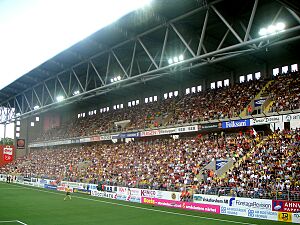
Borås Arena is a football stadium in Borås, Sweden. It is the home ground for IF Elfsborg and Norrby IF. It opened on April 17, 2005. Borås Arena has an artificial turf field. This was updated to the newest synthetic turf in 2012 for the UEFA Euro 2012. This cost £500,000. The stadium can hold 14,500 to 17,800 people, depending on the event. For international matches, the capacity is usually 14,800. This is because Uefa does not allow standing areas due to fire risks. Borås Arena is next to Elfsborg's old home ground, Ryavallen. The two stadiums are connected at their roofs. This means the new stadium is still linked to the historic Ryavallen.
Construction started on December 31, 2003. The stadium opened on April 17, 2005. It cost £1,120,000. This was very cheap at the time for Sweden's most modern stadium. The Borås Municipality helped by lending money to Elfsborg. This was an important investment for the club and the city. Elfsborg would own their stadium through a company called Borås Arena AB. This meant they would get all the money from matches directly. Borås Arena started a new era for IF Elfsborg and other clubs in Allsvenskan. Elfsborg was the first club to build a new stadium owned by their own investment company. Many other clubs have built new stadiums following Elfsborg's example. Owning their stadium gives them a lot of money. Borås Arena has four main stands: Knallelandsläktaren, Ålgårdsläktaren, Sjuhäradsläktaren, and Elfsborgsläktaren.
The first game at Borås Arena was between IF Elfsborg and Örgryte IS on April 17, 2005. It was in the top Swedish league, Allsvenskan. Elfsborg won 1–0. Daniel Mobaeck scored the first goal in Borås Arena's history. The current record attendance is 17,070. This was set on July 4, 2005, in a game between IF Elfsborg and Kalmar FF. This game marked the return of both Anders Svensson and Mathias Svensson. Anders Svensson also scored the first hat-trick at Borås Arena. This was in a derby against rivals IFK Göteborg. Elfsborg won 3–1 with Anders's three goals. The highest attendance for an international tournament was during the Champions League play-off against Valencia CF. 13,148 fans came to watch Elfsborg play the Spanish team. Elfsborg lost 2–1, with a goal by Daniel Alexandersson.
The stadium was supposed to host games for the 2009 UEFA European Under-21 Football Championship. But there was a problem with sponsors. Max fast food chain had a restaurant at the stadium. The official UEFA sponsor was McDonald's. UEFA rules said official sponsors must have a monopoly in the stadium area. Elfsborg refused to close the Max restaurant. So, Borås Arena lost its chance to host the tournament.
2006 was a highlight for Borås Arena. It was the year Elfsborg won their 5th SM-Gold. The club had aimed to win the gold by 2007, and they did it a year early, on November 5, 2006. The club became stronger at all levels, especially in its organization and finances. They had a new sports director, Stefan Andreasson, and a new president, Bosse Johansson. Two rich people also helped fund the club. The new, skilled, and young coaches, Magnus Haglund and Peter Wettergren, joined before the 2004 season. The next year (2005), "Elfsborg Fortress", Borås Arena, was finished. Old heroes like Anders and Mathias Svensson also came back. Memorable matches that season at Borås Arena included the 4–2 home win against Malmö FF. Many said this was the best game of the season. Anders Svensson had his best performance of the season in that game. Another memorable match was the final, crucial one. It was the gold match at a packed Borås Arena against Djurgårdens IF. Joakim Sjöhage scored the only goal, which meant over 40 years of waiting was over for Elfsborg fans.
Supporters
Even in the 1940s, there was a famous Elfsborg chant at Ryavallen. It went "heja di våra, inte di dära, trampa di främmatta pöjka på tära" (meaning something like "cheer for ours, not theirs, step on the foreign boys' toes"). A young Ingvar Carlsson, who later became prime minister, was among those chanting. For a few years in the 1970s, "Di Gule" (The Yellow Ones) played amazing football. They were competing at the top of the Swedish Allsvenskan. At this time, British supporter culture, seen on TV shows, started to influence Swedish football. This also happened at Ryavallen in Borås. A young supporter group was later formed within Elfsborg's fan club. The tradition of standing in the fan section began. Fans wore special hats and striped scarves in Elfsborg's yellow and black colors. For some years, there was a small and unorganized supporter group that didn't make much noise.
Guliganerna
In 1991, IF Elfsborg went through one of its toughest times. The club's money and results were bad. But on November 21, 1991, a group of young men formed a supporter group. This group would become well-known not just in Borås, but across Sweden: Guliganerna. Even though the team kept playing in a lower league and public interest was low, the supporter group, Guliganerna, kept growing. The Guliganerna of the 1990s were known for their loyalty, not their size. They were always there, wherever IF Elfsborg played. Once, in the mid-1990s, the fan bus arrived late for an away game. The players looked worried on the field. After this, the players asked the supporters to promise not to be late for games so it wouldn't distract them.
In 1997, IF Elfsborg was back in the top league of Swedish football. This also meant good things for Guliganerna. In 1997, the first Elfsborg Tifo group was founded, called TGD (Tifosi Guligan Divisione). They did a few tifos, but the members left in 1999, mainly because they didn't have enough money. The year 2000 was the start of a big change in Elfsborg's supporter groups. A group of young boys founded the current tifo group, GTS (Guligan Tifo Support). A younger style became clear among Elfsborg's supporters.
In 2006, 45 years of waiting ended. The club won the national championship. This also made more people interested in Elfsborg. In 2011, Guliganerna celebrated their 20th anniversary. This was done during a game against Kalmar FF. The players wore special anniversary T-shirts. GTS put on the most expensive tifo in the club's history. Guliganerna also broke a new membership record that year, with 1,155 members. This made Guliganerna Sweden's fifth-largest fan base in 2011.
Elfsborg's main rival is IFK Göteborg. This rivalry has existed since the 1920s. The cities are close, making it Elfsborg's only and closest derby. It's also called "El Västico". These games are almost always sold out.
Guliganerna and Peking Fanz (supporters of IFK Norrköping) have a special friendship. This friendship is unique among Swedish supporter groups. It started in the 1990s when Guliganerna invited visiting supporters before matches. Peking Fanz invited them back many times, and the friendship grew. Because of this friendship, both fan bases often go to each other's games. This makes Guliganerna and Peking Fanz special. There are especially strong ties between Elfsborg's only ultras group, Yellow Fanatics, and IFK Norrköping's Peking ultras.
European Football History
Early European Matches (1960s–1980s)
Elfsborg started playing in European competitions in 1961. This was after they won the national championship. That same year, they qualified for the UEFA Intertoto Cup. Elfsborg's first opponent in a European Cup was the German team SC Tasmania 1900 Berlin. Elfsborg won 3–2 away and an impressive 5–2 at home. The next match was against the famous Swiss team FC Basel. Elfsborg lost 1–2 at home but then won the return game 6–3. Henry Larsson scored three goals in that game. The last match was against the tough Sparta Rotterdam. They had not lost a single game before facing Elfsborg. The Dutch team was too strong. Elfsborg lost 2–5 at home and 3–4 away. Despite the losses, Elfsborg finished second in their group. Henry Larsson was the top scorer in the tournament with 8 goals, and Lars Råberg had 6 goals. Five years later, in 1966, Elfsborg continued their European adventures in the UEFA Intertoto Cup. Their first opponent was the German team Borussia Neunkirchen. Elfsborg won both home and away games, with a total score of 4–1. The second match against VSS Košice was very different. They lost 0–3 away but then crushed their opponents 6–0 at home. Roger Carlsson scored three goals in that game. In the final group stage match against the leaders Vorwärts Berlin, Elfsborg lost both games 0–2. This meant Elfsborg finished third in the group.
The next year, 1967, Elfsborg played in the UEFA Intertoto Cup. In the first group stage match, they met the German team Werder Bremen. The first match was a 1–4 loss away, but the second game was a 2–2 draw at home. In the second game, the Polish team Polonia Bytom was their opponent. Elfsborg lost both matches. But in the last match against the Swiss team Grasshopper Club Zürich, Elfsborg got a memorable win. They beat them 5–2 at home, with three goals from Lars Heinemann. The return game was a 1–3 loss. Elfsborg finished third in their group again. 1971 was not a good year for Elfsborg in European competitions. They played against Stal Mielec, Tatran Prešov, and Vejle BK. They lost every game except against the Danish team Vejle BK. They won both games against them with a total score of 8–0. Elfsborg finished third in their group once more. In 1972, Elfsborg played in the UEFA Cup for the first time. They played against the famous German champions Hertha Berlin in the first round. They lost 1–4 at Olympic Stadium and 1–4 at home.
1975 was Elfsborg's worst year in European competition. They finished last in their UEFA Intertoto Cup group. They played against teams like Baník Ostrava, Celik Zenica, and Vitoria Setúbal. Elfsborg still won at home against Baník Ostrava 3–1 and drew against Vitoria Setúbal. In 1978, Elfsborg played in the UEFA Intertoto Cup again. This year was a bit better than 1975. Elfsborg won 5–3 overall against Norwegian team Lillestrøm SK. They also won against former Yugoslav team Sloboda Tuzla. But Elfsborg could not beat the strong Israeli team Maccabi Netanya F.C.. They lost the first game 1–7 away but managed a 2–2 draw at home. In 1978, Elfsborg was in the UEFA Cup for the second time. They played against the strong French team RC Strasbourg. In the first game, Elfsborg surprisingly won 2–0 at home. But in the return game, they lost 1–4 in front of 31,000 fans.
Return to European Football (2000s–Present)
It took almost 20 years for Elfsborg to play in European cups again. After a very tough period in the club's history, Elfsborg was back at the top of Allsvenskan. They played in the UEFA Cup in 2001 after winning the national cup. They played against JK Trans Narva in the first round. They won 3–1 away and then 5–0 at home, with three goals from Stefan Andreasson. The second round was against one of the big Polish teams, Legia Warsaw. Elfsborg lost with a total score of 2–10. After winning the national cup again, Elfsborg played in the UEFA Cup in 2004. Their opponents in the first round were Glentoran F.C., who they beat 3–1 overall. In the next round, Elfsborg played against Croatian team NK Dinamo Zagreb. Elfsborg lost the first game 0–2 away and then drew 0–0 at home. After winning the national championship in 2006, Elfsborg played in the UEFA Champions League for the first time. This was in 2007. The first round was against Linfield FC. Elfsborg drew 0–0 in the first match. Then they won 1–0 at home with a goal by Mathias Svensson. The second round was against Hungarian team Debreceni VSC. They won 1–0 away with a goal by Daniel Mobaeck. They secured their spot in the third round by drawing 0–0 at home. The third round was against Spanish giants Valencia CF. 50,000 fans at the Mestalla Stadium saw Elfsborg lose 0–3. David Silva scored one of the goals. Back at Borås Arena, Elfsborg lost again 1–2. Daniel Alexandersson scored for Elfsborg, and David Villa scored Valencia's winning goal.
After their good results in the UEFA Champions League, Elfsborg went straight to the 2007–08 UEFA Cup group stage. They played against FC Dinamo București, AEK Athens, ACF Fiorentina, FK Mladá Boleslav, and Villarreal CF. Elfsborg won against FC Dinamo București 2–1 and drew against AEK Athens 1–1. The next year, 2008, Elfsborg won the UEFA Intertoto Cup for the last time. They beat teams like HB Tórshavn (2–1 total), Hibernian FC (4–0 total), and FK Riga (1–0 total). This meant they finished as group winners. That same year, they also played in the UEFA Cup for the last time. They lost surprisingly 3–4 overall to the Irish team St Patrick's Athletic F.C.. In 2009, Elfsborg started playing in the UEFA Europa League for the first time. In the second round, they beat Szombathelyi Haladás 3–0 overall. In the third round, they played against Portuguese team S.C. Braga, who were finalists in the 2010–11 UEFA Europa League. Elfsborg beat them with a total score of 4–1. In the final play-off round, Elfsborg played against the famous S.S. Lazio. They lost the first game 0–3 but then won heroically 1–0 with a goal by Denni Avdic.
In 2010, Elfsborg played in the UEFA Europa League again. They beat FC Iskra-Stal 3–1 overall in the second round. The third round was against FK Teteks from Macedonia. Elfsborg easily won that series 7–1. The play-off round was again against a famous Italian team, Maradona's old club SSC Napoli. Elfsborg's goalkeeper Jesper Christiansen played amazingly. They only lost 0–1 away at Stadio San Paolo. But back at the Borås Arena, Elfsborg lost 0–2. Both goals were scored by Edinson Cavani, who became very famous after this match. In 2011, Elfsborg played in the UEFA Europa League for the third year in a row. They beat CS Fola Esch 5–1 overall in the first round. The second round was against FK Suduva, who they easily beat 4–1 overall. But in the third round, Elfsborg surprisingly lost 1–5 overall to the Norwegian team Aalesunds FK. They failed to reach the play-offs. The same thing happened in 2012. Elfsborg had a perfect start in the qualification. They won their home game in the first stage against Floriana F.C. 8–0. This was Elfsborg's biggest international victory ever. The away game was also easy, with Elfsborg winning 5–0, for a total of 13–0. In the second stage, their opponents were FC Dacia Chişinău. Elfsborg lost the first game 0–1 after a weak performance. But they won easily 2–0 at Borås Arena and moved to the third stage. In the third stage, it was a Scandinavian battle against Danish team AC Horsens. The first away game was a 1–1 draw. Horsens got a penalty in extra time. But in their home game, Elfsborg lost 2–3. History repeated itself from the previous year. Elfsborg failed to reach the play-offs again.
European Statistics
(As of June 22, 2015)
| Competition | Games Played | Wins | Draws | Losses | Goals For | Goals Against |
|---|---|---|---|---|---|---|
| Champions League | 10 | 4 | 3 | 3 | 14 | 7 |
| UEFA Cup / Europa League | 116 | 47 | 21 | 48 | 177 | 160 |
Club Officials
Organization
| Role | Name | Nation |
|---|---|---|
| Chairman | Bo Johansson | |
| Director | Stefan Andreasson |
Technical Staff
| Role | Name | Nation |
|---|---|---|
| Manager | Oscar Hiljemark | |
| Assistant manager | Emir Bajrami | |
| Assistant manager / Fitness | Miguel Beas | |
| Fitness | Dan Fransson | |
| Goalkeeping coach | Linus Eriksson | |
| Scout | Anders Svensson | |
| U21 Coach | Tobias Linderoth | |
| Fitness coach | Victor Stoltz | |
| Physiotherapist | Jan Andblad | |
| Physiotherapist | Johan Meldo | |
| Club doctor | Matilda Lundblad | |
| Kit manager | Stefan Ågren | |
| Kit manager | Reima Haukka | |
| Football administrator | Martin Andersson |
Youth Section
Notable Managers
Here are some important managers for IF Elfsborg:
| Name | Nation | Years | Honours |
|---|---|---|---|
| Carl Larsson | 1916–1925, 1926–1930, 1930–1938 | Managed for 21 years in total. | |
| Carl Larsson & Thure Claesson | 1930–1938 | 1 Swedish Championship | |
| Sven Zachrisson | 1938–1946, 1959–1960 | 2 Swedish Championship | |
| Karl-Erik Grahn | 1949–1952, 1961–1962 | 1 Swedish Championship | |
| Thure Nygren | 1957–1958, 1963–1967, 1970–1972 | Managed for 7 years in total. | |
| Rolf Svensson | 1977–1982 | Managed for 5 years in total. | |
| Bengt-Arne Strömberg | 1999–2001 | 1 Svenska Cupen | |
| Anders Grönhagen | 2002–2003 | 1 Svenska Cupen | |
| Magnus Haglund | 2004–2011 | 1 Swedish Championship, 1 Svenska Supercupen, 1 The Atlantic Cup | |
| Jörgen Lennartsson | 2012–2013 | 1 Swedish Championship | |
| Klas Ingesson | 2013–2014 | 1 Svenska Cupen |
Club Achievements
Swedish Titles
- Swedish Champions:
- Winners (6): 1935–36, 1938–39, 1939–40, 1961, 2006, 2012
League Titles
- Allsvenskan:
- Winners (6): 1935–36, 1938–39, 1939–40, 1961, 2006, 2012
- Second Place (8): 1942–43, 1943–44, 1944–45, 1965, 1977, 2008, 2020, 2023
- Division 1 Södra:
- Winners: 1996
- Division 2 Götaland:
- Winners: 1960
- Division 2 Västsvenska Serien:
- Winners: 1925–26
Cup Titles
- Svenska Cupen:
- Winners (3): 2000–01, 2003, 2013–14
- Runners-up (3): 1942, 1980–81, 1996–97
- Svenska Supercupen:
- Winners: 2007
European Titles
- UEFA Intertoto Cup:
- Winners: 1980, 2008 (joint winner)
Club Records
In 2024, Elfsborg played its 81st season in Allsvenskan. This places them 5th among teams that have played the most seasons. They have also played in the top league in Sweden continuously since 1997. This is the 3rd longest time for any club in Sweden. IFK Göteborg has the longest, since 1977.
The club is currently 5th in the all-time Allsvenskan table. This table shows all match results, points, and goals for every team since 1924–25. Elfsborg is also 6th in the all-time medal table. They have won 24 medals of different types. The most recent was in 2012.
The player who holds the most club and national records for IF Elfsborg is Sven Jonasson. He played 409 games, which is the most appearances ever for Elfsborg. He scored a total of 252 goals in Allsvenskan, which is an all-time record. He played for Elfsborg his whole career, from 1927 to 1947, a total of 20 years. His most amazing achievement is his record of 344 games played in a row. This record was broken in a sad way. He missed his first game in 14 years because he couldn't get time off from his military service. He was also the first goalscorer ever for the Sweden men's national football team in a World Cup. This was in the 1934 FIFA World Cup. He scored two goals in Sweden's 3–2 win against Argentina.
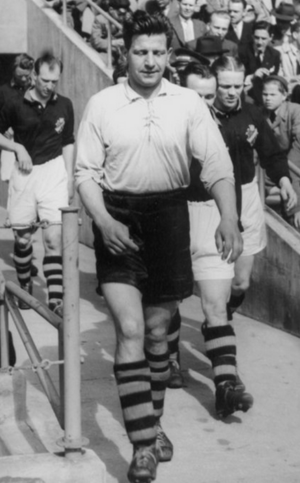
- Most appearances, total: 409,
 Sven Jonasson
Sven Jonasson - Most goals scored, total: 252,
 Sven Jonasson*
Sven Jonasson* - Most appearances for Sweden while playing for Elfsborg, total: 106,
 Anders Svensson*
Anders Svensson* - Most consecutive games, total: 344,
 Sven Jonasson, 1927–41*
Sven Jonasson, 1927–41* - Biggest victory, Svenska cupen: 19–0 vs. Varbergs BoIS, January 21, 1996*
- Biggest defeat, Allsvenskan: 0–7 vs. GAIS, August 25, 1926
- Home victory, Allsvenskan: 10–1 vs. Degerfors IF, August 28, 1938
- Away victory, Allsvenskan: 12–2 vs. IFK Eskilstuna, April 19, 1936*
- International victory, UEFA Europa League: 8–0 vs. Floriana F.C., July 5, 2012*
- Highest attendance, Ryavallen: 22,654 vs. IFK Norrköping, 1961
- Highest attendance, Borås Arena: 17,070 vs. Kalmar FF, July 4, 2005
- Highest attendance, Ramnavallen: 16,340 vs. AIK, June 7, 1936
- Highest average attendance, season 1961: 14,608
- Highest away attendance, Ullevi: 48,296 vs. IFK Göteborg, June 2, 1977
![]() Allsvenskan all-time record.
Allsvenskan all-time record.
Team Records: Top Scorers and Appearances
Most Goals
League, Allsvenskan
| # | Name | Nation | Career | Goals |
|---|---|---|---|---|
| 1 | Sven Jonasson | 1927–47 | 252 | |
| 2 | Thomas Ahlström | 1971, 1973–79, 1982–84 | 101 | |
| 3 | Knut Johansson | 1936–44 | 92 | |
| 4 | Henry Larsson | 1952–54, 1961–68 | 80 | |
| 5 | Åke Samuelsson | 1930–41 | 76 | |
| 6 | Gillis Andersson | 1933–43 | 67 | |
| 7 | Ove Grahn | 1961–65 | 62 | |
| 8 | Karl-Erik Grahn | 1932–49 | 57 | |
| 9 | Anders Svensson | 1997–01, 2005–2015 | 56 | |
| 10 | Fredrik Berglund | 1997–01, −03, 2007–08, −10 | 54 |
Most Appearances
League, Allsvenskan
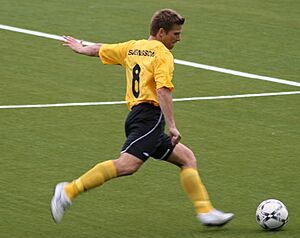
| # | Name | Nation | Career | Appearances |
|---|---|---|---|---|
| 1 | Sven Jonasson | 1927–47 | 409 | |
| 2 | Karl-Erik Grahn | 1932–49 | 346 | |
| 3 | Leif Målberg | 1965–71, 1973–80 | 337 | |
| 4 | Anders Svensson | 1997–01, 2005–2015 | 289 | |
| 5 | Leif Gustafsson | 1970–71, 1973–82, −84 | 276 | |
| 6 | Thomas Johansson | 1973–83 | 276 | |
| 7 | Arvid Samuelsson | 1933–47 | 270 | |
| 8 | Johan Karlsson | 2001–11 | 263 | |
| 9 | Göran Ahlström | 1969–71, 1973–81 | 258 | |
| 10 | Thomas Ahlström | 1971, 1973–79, 1982–84 | 237 |
Images for kids
-
Play order for the FIFA World Cup 1958, Borås and Ryavallen are number 22.
-
Ålgårdsläktaren, in a derby against IFK Göteborg.
-
S.S Lazio–Elfsborg at the Stadio Olimpico in Rome, Europa League play-off 2009.
See also
 In Spanish: IF Elfsborg para niños
In Spanish: IF Elfsborg para niños


